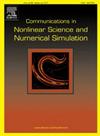Resonances in nonlinear systems with a decaying chirped-frequency excitation and noise
IF 3.4
2区 数学
Q1 MATHEMATICS, APPLIED
Communications in Nonlinear Science and Numerical Simulation
Pub Date : 2025-02-25
DOI:10.1016/j.cnsns.2025.108713
引用次数: 0
Abstract
The influence of multiplicative white noise on the resonance capture of strongly nonlinear oscillatory systems under chirped-frequency excitations is investigated. It is assumed that the intensity of the perturbation decays polynomially with time, and its frequency grows according to a power low. Resonant solutions with a growing amplitude and phase, synchronized with the excitation, are considered. The persistence of such a regime in the presence of stochastic perturbations is discussed. In particular, conditions are described that guarantee the stochastic stability of the resonant modes on infinite or asymptotically large time intervals. The technique used is based on a combination of the averaging method, stability analysis and construction of stochastic Lyapunov functions. The proposed theory is applied to the Duffing oscillator with a chirped-frequency excitation and noise.
求助全文
约1分钟内获得全文
求助全文
来源期刊

Communications in Nonlinear Science and Numerical Simulation
MATHEMATICS, APPLIED-MATHEMATICS, INTERDISCIPLINARY APPLICATIONS
CiteScore
6.80
自引率
7.70%
发文量
378
审稿时长
78 days
期刊介绍:
The journal publishes original research findings on experimental observation, mathematical modeling, theoretical analysis and numerical simulation, for more accurate description, better prediction or novel application, of nonlinear phenomena in science and engineering. It offers a venue for researchers to make rapid exchange of ideas and techniques in nonlinear science and complexity.
The submission of manuscripts with cross-disciplinary approaches in nonlinear science and complexity is particularly encouraged.
Topics of interest:
Nonlinear differential or delay equations, Lie group analysis and asymptotic methods, Discontinuous systems, Fractals, Fractional calculus and dynamics, Nonlinear effects in quantum mechanics, Nonlinear stochastic processes, Experimental nonlinear science, Time-series and signal analysis, Computational methods and simulations in nonlinear science and engineering, Control of dynamical systems, Synchronization, Lyapunov analysis, High-dimensional chaos and turbulence, Chaos in Hamiltonian systems, Integrable systems and solitons, Collective behavior in many-body systems, Biological physics and networks, Nonlinear mechanical systems, Complex systems and complexity.
No length limitation for contributions is set, but only concisely written manuscripts are published. Brief papers are published on the basis of Rapid Communications. Discussions of previously published papers are welcome.
 求助内容:
求助内容: 应助结果提醒方式:
应助结果提醒方式:


